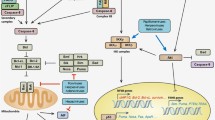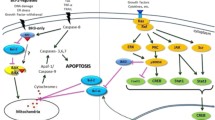Abstract
To date much attention has been focused on regulation of apoptosis in proliferating cells. However, recent evidence shows that regulation of apoptosis in quiescent tissue plays an important role in homeostasis of the organism. This review examines the implications of apoptosis of quiescent cells for both tumourigenesis and viral infection such as HIV. In this article we propose a dual role for cellular activation in the homeostasis regulation. In this model cellular mitogens not only activate quiescent cells into the active cell cycle, but under certain conditions, loss of quiescence may result in apoptosis. The loss of quiescence-associated apoptosis may play a significant role in tumourigenesis and viral infections.
Similar content being viewed by others
References
Weinberg RA. The cat and mouse games that genes, viruses, and cells play. Cell 1997; 88: 573.
Debbas M, White E. Wild-type p53 mediates apoptosis by E1A which is inhibited by E1B. Genes Dev 1993; 7: 546.
Hermeking H, Eick D. Mediation of c-myc-induced apoptosis by p53. Science 1994; 256: 2091.
Hirakawa T, Ruley HE. Rescue of cells from ras oncogene-induced growth arrest by a second, complementing oncogene. Proc Natl Acad Sci USA 1988; 85: 1519.
Kerr JFR, Harmon BV. Definition and incidence of apoptosis: Ahistorical perspective. In: Tomei LD, Cope FO, eds. Apoptosis: The Molecular Basis of Cell Death. Plainview, NY (USA): Cold Spring Harbor Laboratory Press, 1991: 5–29.
Wyllie AH, Kerr JFR, Currie AR. Cell death: the significance of apoptosis. Int Rev Cytol 1980; 68: 251.
Kerr JFR, Searle J, Harmon BV, Bishop CJ. Apoptosis. In: Potten CS, ed. Perspectives on Mammalian Cell Death. New York, NY (USA): Oxford University Press, 1987: 93–178.
Cohen JJ, Duke RC, Fadok VA, Sellins KS. Apoptosis and programmed cell death in immunity. Ann Rev Immun 1992; 10: 267.
Moore JV. Perspectives on mammalian cell death. In: Potten CS, ed. Death of Cells and Necrosis of Tumours. Oxford, UK: Oxford University Press, 1987: 295.
Buttyan R, Olsson CA, Pintar J. Cascade induction of c-fos, c-myc, and heat shock 70K transcripts during regression of the rat ventral prostate gland. Mol Endocrinol 1988; 2: 650.
Prochownik EV, Kukowska J, Rodgers C. c-Myc antisense transcripts accelerate differentiation and inhibit G1 progression in murine erythroleukemia cells. Mol Cell Biol 1988; 8: 3683.
Buttyan R. Genetic response of prostate cells to androgen deprivation: insights into the cellular mechanisms of apoptosis. In: Tomei LD, Cope FO, eds. Apoptosis: The Molecular Basis of Cell Death. Plainview, NY (USA): Cold Spring Harbor Laboratory Press, 1991: 157–173.
Evan GI, Wyllie AH, Gilbert CS. Induction of Apoptosis in Fibroblasts by c-myc. Cell 1992; 69: 119.
Shi Y, Glynn JM, Guibert LJ, Cotter TG, Bissonnette RP, Green DR. Role for c-myc in activation-induced apoptotic cell death in T cell hybridomas. Science 1992; 257: 212.
Gibson AW, Cheng T, Johnston R. Apoptosis induced by c-myc overexpression is dependent on growth conditions. Exp Cell Res 1995; 218: 351.
Scott DW, Lamers M, Kohler G, Sidman CL, Maddox B, Carsetti R. Role of c-myc and CD45 in spontaneous and antireceptor-induced apoptosis in adult murine B cells. Inter Immunol 1996; 8: 1375.
Armstrong DK, Kaufmann SH, Ottaviano YL. Epidermal growth factor-mediated apoptosis of MDA-MB-468 human breast cancer cells. Cancer Res 1994; 54: 5280.
Heldin CH. Structural and functional studies on platelet-derived growth factor. EMBO 1992; 11: 4251.
Kim HRC, Upadhyay S, Li G, Palmer KC, Deuel TF. Platelet-derived growth factor induces apoptosis in growth-arrested murine fibroblasts. Proc Natl Acad Sci USA 1995; 92: 9500.
Harrington EA, Bennett MR, Fanidi A, Evan GI. c-Myc-induced apoptosis in fibroblasts is inhibited by specific cytokines. EMBO 1994; 13: 3286.
Xu Y, Nguyen Q, Lo DC, Czaja MJ. c-Myc-dependent hepatoma cell apoptosis results from oxidative stress and not a deficiency of growth factors. J Cell Phys 1997; 170: 192.
Ho DD, Neumann AU, Perelson AS, Chen W, Leonard JM, Markowitz M. Rapid turnover of plasma virions and CD4 lymphocytes in HIV-1 infection. Nature (London) 1995; 373: 123.
Wei X, Ghosh SK, Taylor ME. Viral dynamics in human immunodeficiency virus type 1 infection. Nature (London) 1995; 373: 118.
Li CJ, Friedman DJ, Wang C, Metelev V, Pardee AB. Induction of apoptosis in uninfected lymphocytes by HIV-1 Tat protein. Science 1995; 268: 429.
Lenardo MJ. Interleukin-2 programs mouse alpha beta T lymphocytes for apoptosis. Nature 1991; 353: 858.
Shi L, Nishioka WK, Th'ng J, Bradbury EM, Litchfield DW, Greenberg, AH. Premature p34cdc2 activation required for apoptosis. Science 1994; 263: 1143.
Meikrantz W, Gisselbrecht S, Tam SW, Schlegel R. Activation of cyclin A-dependent protein kinases during apoptosis. Proc Natl Acad Sci USA 1994; 91: 3754.
Li CJ, Ueda Y, Shi B. Tat protein induces self-perpetuating permissivity for productive HIV-1 infection. Proc Natl Acad Sci USA 1997; 94: 8116.
Westendorp MO, Frank R, Ochsenbauer C. Sensitization of T cells to CD95-mediated apoptosis by HIV-1 Tat and gp120. Nature (London) 1995; 375: 497.
Adler B, Adler H, Pfister H, Jungi TW, Peterhans E. Macrophages infected with cytopathic bovine viral diarrhea virus release a factor(s) capable of priming uninfected macrophages for activation-induced apoptosis. J Virology 1997; 71: 3255.
Adler B, Adler H, Jungi TW, Peterhans E. Interferon-alpha primes macrophages for lipopolysaccharide-induced apoptosis. Biochem Biophys Res Comm 1995; 215: 921.
Weinberg RA. The retinoblastoma protein and cell cycle control. Cell 1995; 81: 323.
Gaben AM, Saucier C, Bedin M. Activation of p21ras is not sufficient to ensure a complete G1 phase of the cell division cycle in mouse fibroblasts. Oncogene 1996; 13: 2113.
Author information
Authors and Affiliations
Rights and permissions
About this article
Cite this article
Borodyansky, L., Li, YZ., Pardee, A.B. et al. Apoptosis in non-proliferating cells: implications for viral infection and tumourigenesis. Apoptosis 3, 381–385 (1998). https://doi.org/10.1023/A:1009693517181
Issue Date:
DOI: https://doi.org/10.1023/A:1009693517181




